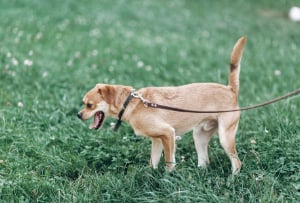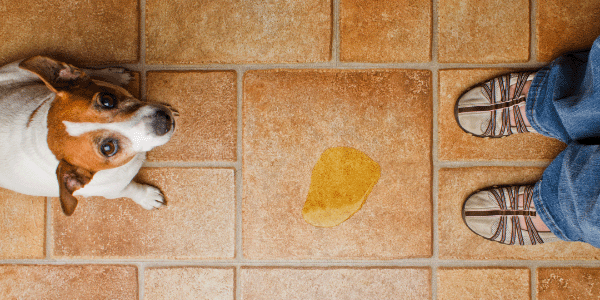 Potty training isn't just for puppies! Adult dogs might need a refresher on house training if you've noticed a regression, or they might never have learned that they're only supposed to go potty outside.
Potty training isn't just for puppies! Adult dogs might need a refresher on house training if you've noticed a regression, or they might never have learned that they're only supposed to go potty outside.
Some dogs need help transitioning from using pee pads to only going outdoors.
Whether you've just adopted an adult dog that needs some potty training or your adult dog is suddenly having accidents inside, read on for reasons why this might be happening and how to house train your adult dog.
Skip Ahead
Life Changes That Contribute to Potty Training Regression
Transitioning to a new routine or environment can be challenging for many dogs. The time it takes to acclimate to a recent change is called the "adjustment period," and some dogs regress in their potty training during this time. This lapse in potty training can be caused by stress and anxiety, or might also happen because of missed potty breaks, and the dog has to "hold it" longer than they're used to.
- Recently adopted or re-homed
- Change in schedule (humans go back to work, children go back to school, change in work schedule, etc.)
- Moving
- Addition of another pet to the home
- The recent loss of a family member (human or animal)
The adjustment period might pass quickly for some dogs, while others take longer to get used to their new home and schedule. It's important to allow your dog to adjust at their own pace. You can help your dog feel safe and secure through their adjustment period by setting up a safe space for them, sticking to a predictable daily routine, and providing lots of mental enrichment activities throughout the day. This can help relieve stress and anxiety after a significant life change.
In some cases, a newly adopted or re-homed dog might have potty accidents during the adjustment period. Don't worry just yet! Many of these dogs will bounce back to being fully house-trained once they've settled in and have learned the new routine. You might not need to go through a rigorous re-training for these dogs, just make sure they are getting lots of outdoor potty breaks and rewarding them for going in their new potty spot.
Is Your Dog Urine Marking?
Suppose you've recently moved to a new home. In that case, your dog might be smelling previous pet accidents that weren't cleaned up properly and marking over them. Or if you brought home a new puppy that had a potty accident, your adult dog might want to potty in the same spot.
Make sure to thoroughly clean pee and poo accidents to discourage future accidents. You'll want to also increase supervision while your dog is indoors so you can interrupt and redirect marking behavior when you see signs they are about to lift a leg or squat. Take them outside immediately if you see these signs and praise them for going where it's appropriate. For dogs with a long history of marking, keep them tethered to you on a leash to preempt any marking.
If your dog is intact, neutering or spaying — yes, female dogs may mark! — can decrease urine marking. However, there are other things to consider when deciding when to spay or neuter your dog.
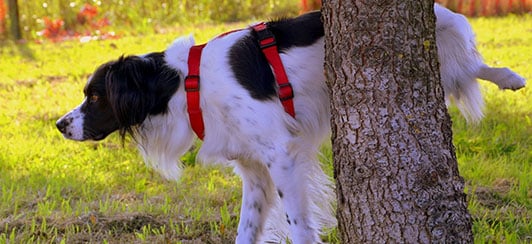 Medical Issues that Inhibit Potty Training
Medical Issues that Inhibit Potty Training
If your previously house-trained adult dog is suddenly having accidents inside, it might be a sign that there is a medical reason. Speak with your veterinarian to rule out or diagnose possible medical issues.
Medical problems that often cause regression in potty training:
- Urinary tract infection
- Bladder inflammation ("cystitis")
- Bladder or kidney stones
- Kidney disease
- Skin infections of the vulvar or preputial folds
- Metabolic/endocrine diseases like diabetes, Cushing's, and Addison's disease
- Certain GI upsets
- Canine Cognitive Dysfunction, also known as "Doggy Dementia"
Questions? To chat with a veterinarian about whether your dog's potty problems may be caused by a medical issue, Click here
Was Your Dog Never Fully House Trained?
While we might think that our adult dog is fully house trained, sometimes we humans skip a few steps in potty training or don't completely finish the process with our dogs. We've learned to live with the random accidents we find in the house. In my experience, I tend to see this happen most often with toy or small breed dogs. Owners of small dogs tend not to mind as much about the pee or poo they find because it's small and not too cumbersome to clean (compared to a Great Dane's accident, which is like stepping in a lake).
How Long Can Adult Dogs "Hold It"?
Dogs over one-year-old with no medical issues can be expected to hold their bladder and bowels for up to 10 hours (assuming they've been given the chance to go after a meal) — BUT this doesn't mean they should have to hold it that long! We can all certainly relate to the discomfort of having to hold it when we've gotta go.
Ideally, potty trained dogs should be given multiple chances to relieve themselves outside at least once every six to eight hours.
Consider whether your dog's house training was truly finished. "Finished" in this sense means that your dog can hold it for a reasonable amount of time. Many fully house-trained dogs will clearly indicate when they need to go to the bathroom by sitting at the door, or pawing and whining at their owner. If your healthy adult dog can hold it for only two or three hours, but waiting any longer means they have an accident, it's time to go back to the basics and work on extending their schedule.
A healthy adult dog should be able to hold it longer than a couple of hours. Or if your dog doesn't show signs of needing to go potty outside, they might not have made the connection that inside is off-limits for bathroom breaks. Learn how to "go back to kindergarten" further below for potty training in these cases.
Dogs rescued from unfortunate circumstances, such as hoarding cases, puppy mills, or irresponsible breeders, often have a difficult time with house training. You might be working against a history of going potty anywhere in a home, or being kept confined in crates without alternative and appropriate potty areas. These dogs deserve compassion and patience as they learn a new potty routine.
Depending on the severity of their housebreaking issues, using indoor potty spots, such as pee pads or grass patches, may be helpful before transitioning to only going to the bathroom outside. Just like a brand-new puppy, adult dogs from these situations often need to start from square one.
Canine Separation Anxiety and Potty Accidents
Potty accidents might be a sign that a dog has separation anxiety. Still, it's important not to jump to this conclusion without ruling out other possible causes. Separation anxiety-related potty accidents only occur when the dog is left alone or separated from a particular person. The dog is in a state of panic and cannot control their bladder or bowels — they literally can't help themselves. If your dog only has accidents when left alone, they aren't taking revenge on you or trying to teach you a lesson.
If you think your dog's potty accidents might be happening because of separation anxiety, connect with your veterinarian or veterinary behaviorist for diagnosis and any needed treatments. You'll also want to work with a certified dog trainer or behavior consultant to begin a behavior and training plan to treat separation anxiety.
How to House Train an Adult Dog
Going "Back to Kindergarten"
Potty training an adult dog isn't very different from potty training a puppy! While the steps are the same, adult dogs might take longer to potty train than a brand new puppy. You're competing with their previous history and learned habits — breaking bad habits is always harder than learning new ones. Don't expect too much from your dog too soon.
Consistency and patience are the two most important ingredients for successful potty training, no matter your dog's age.
For the full step-by-step guide to beginning potty training, check out "How to Potty Train a Puppy."
Use Your Dog's Crate or Set Up a "Dog Zone"
Dogs don't like to go to the bathroom where they rest, eat, or play. Your adult dog might consider one area of your house the "inside," where they don't go potty, and another room or place as the "outside" — far enough away from their main resting area to not bother them. By blocking off free access to large spaces, we can piggyback on their instinct to keep their area clean and accelerate potty training.
If your dog is crate trained, you can use this to your advantage and begin using the crate as their starting confinement area. For dogs who are not crate trained or need a bit more space to roam between potty breaks, set up a "dog zone" confinement area using a dog playpen. This dog zone is a modified puppy zone. The only difference is you don't want to include pee pads in the adult dog's playpen.
You can create your dog's zone by using baby gates to block off doorways and hallways or use a portable playpen. You can also customize your dog's zone using exercise pen panels, like these from MidWest Pets, that can be arranged as an enclosed pen or used as fencing around areas that are off-limits.
When they aren't under your direct supervision, your dog should be in the crate or "dog zone" to prevent wandering off and having an accident inside. When not confined, your dog should be tethered to you (I recommend using this hands-free leash from TuffMutt) or under close supervision to watch for signs they need a bathroom break.
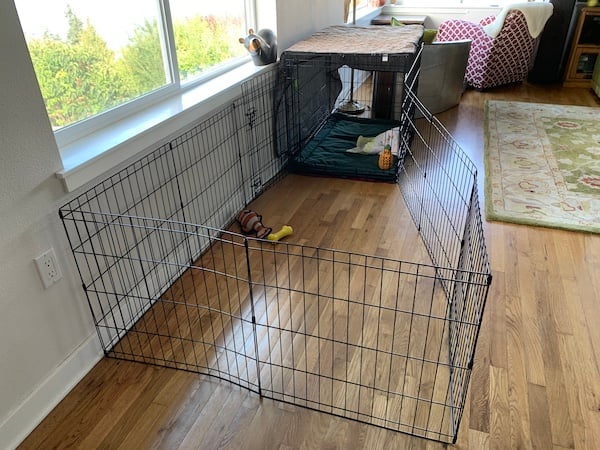
Start to Expand Your Dog's Zone
When your dog can go at least five days without an accident in their area, it's time to make it a bit bigger! Don't add too much space too fast. If you've been using their crate, add an exercise pen around their crate before allowing them more room to roam. Use baby gates and exercise pen panels to block off areas as needed as you allow them the freedom to roam part or all of a particular room. Here's a picture example of a beginning "dog zone" using an exercise pen around a crate:
If your dog has an accident in their designated area, clean it thoroughly, and go back to a smaller-sized area where they were previously successful. If not cleaned properly, your dog may use the same spot again because of the smell.
Reward Outside Potty Habits
Every time your dog goes to the bathroom outside, reward them with a treat and praise! We want them to truly understand that doing their business outside means something amazing happens. As your dog is finishing up their business, say "yes" and then give them the treat. Try to time this so you're not interrupting them before they're totally empty.
Take Frequent Potty Breaks
If we want our dogs to learn to go potty only outside, we need to give them the opportunity. Some adult dogs need to go all the way back to the beginning and have potty breaks outside at least once an hour. Others simply need a few more breaks added into their schedule to match their physical ability to hold it for certain amounts of time.
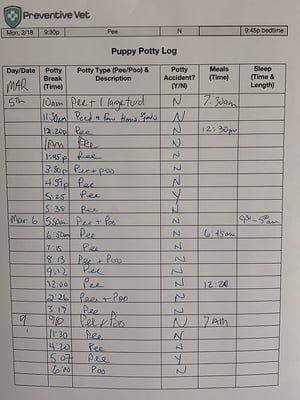
Keep a potty log the first week you start retraining your dog. This will help you track their schedule and might show you patterns in their potty routine.
Look at your filled-out Potty Log and consider these questions:
- Am I taking my dog out frequently enough to prevent accidents?
- What's the maximum amount of time my dog can hold it between these logged potty breaks?
- Has my dog gone at least five days without an accident? Can I start extending the time between potty breaks?
- Are accidents happening around the same time each day? (After mealtimes? Overnight? While you're gone?)
If there are accidents around the same time each day, or after a particular activity, adjust your potty break schedule to prevent these accidents. Give them a chance to relieve themselves beforehand. When you can see the amount of time your dog has successfully held it between breaks, that gives you an excellent gauge for where to start when extending intervals between bathroom breaks.
How to Help Your Dog "Hold It" Longer
When you begin to extend the time between potty breaks for your adult dog, do so in small increments. You're helping their bladder and bowels learn how to physically hold it longer than they've previously been able to. If your dog can go for four hours without an accident, start with just waiting four and a half hours between breaks for the first week. Then up to five hours, as long as there hasn't been an accident. If four and a half hours was too long and your dog had an accident, make it easier by just waiting four hours and fifteen minutes.
Nighttime Potty Breaks
Here's some good news — adult dogs usually don't need nighttime bathroom breaks as young puppies do. Yay for uninterrupted sleep!
However, if your dog has nighttime accidents, you will need to set up their environment for success. This might mean crating them at night or having them sleep in their larger playpen. You don't want them wandering through the home looking for a potty spot while you're asleep. If your dog has morning accidents, set an earlier alarm so you can take them out to go to the bathroom. And always give them a bathroom break as late as possible before going to bed each night.
Watch for Signs Your Dog Needs to Go to the Bathroom
Carefully watching your dog during remedial potty training is crucial for success. Take note of your dog's signals that they need to go so you can prevent an indoor accident. When you're unable to watch them closely, place them in their crate or larger dog zone to help prevent accidents, and encourage them to hold it.
Signs that mean your dog might need to go potty:
- Sniffing the floor
- Seeking out a hiding spot or somewhere out of the way
- Pacing or circling
- Going to the door
- Pawing at the door or you
- Whining or barking
- Licking their groin or rear-end area
Regression in Your Dog's Potty Habits
If your dog has a sudden change in their bathroom habits, it's best to have your veterinarian check them over to ensure there is no medical cause. Even without a medical reason, it's not too unusual for potty training regression, especially if there has been a change in routine or as your dog matures into their senior years.
When starting potty training over with an adult dog, remember that it's all about consistency as your dog relearns appropriate potty habits. There might be a few bumps along the way, but your hard work will pay off!
We'd love to hear about your experience in potty training your adult dog.
Let us know what's worked for you in the comments!


